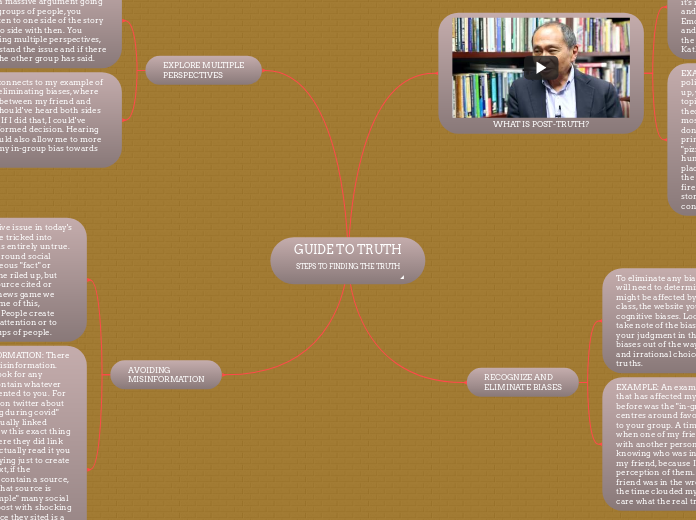GUIDE TO TRUTH
STEPS TO FINDING THE TRUTH
^
WHAT IS POST-TRUTH?
"'Post-truth' is often understood as involving people's emotions rather than their critical abilities to make distinctions. And I think that might be true but i think it's important to keep in mind that emotion and truth are not two different things. Emotion has to do with what we care about and truths have to do with things that are the case. The two have to work together." — Kathleen Higgins
EXAMPLE: A big example of post-truth politics are conspiracy theories being made up, where false rumors become big news topics. There have been conspiracy theories proved true, like "Watergate", but most are lies, some being so outrageous I don't know how they were come up with. A prime example of a made up controversy is "pizzagate", where lies were made up about a human-trafficking ring supposedly taking place in a pizzeria. This led to a believer of the conspiracy to enter the pizza place and fire a rifle inside, to break the lock to the storage room and "investigate" the conspiracy.
RECOGNIZE AND
ELIMINATE BIASES
To eliminate any biases you might have, you will need to determine which biases you might be affected by. As previously used in class, the website yourbias.is lists 24 cognitive biases. Look through this site and take note of the biases that have affected your judgment in the past. Without getting biases out of the way, you will make poor and irrational choices when it comes to truths.
EXAMPLE: An example of a cognitive bias that has affected my perception of truth before was the "in-group" bias. This bias centres around favouring those who belong to your group. A time this has affected me is when one of my friends was in an argument with another person. Instantly, without knowing who was in the right, I sided with my friend, because I have a positive perception of them. As it turned out, my friend was in the wrong, but my biases at the time clouded my judgment, so I did not care what the real truth was.
EXPLORE MULTIPLE
PERSPECTIVES
When tackling truth, you want to explore multiple perspectives and not just one side. Lets say there is a massive argument going on between two groups of people, you shouldn't just listen to one side of the story and decide who to side with then. You should be exploring multiple perspectives, to further understand the issue and if there is truth to what the other group has said.
EXAMPLE: This connects to my example of recognizing and eliminating biases, where in the argument between my friend and someone else, I should've heard both sides of the argument. If I did that, I could've made a better informed decision. Hearing the other side could also allow me to more easily eliminate my in-group bias towards my friend.
AVOIDING
MISINFORMATION
Misinformation is a massive issue in today's society. It is very easy to be tricked into believing something that is entirely untrue. I often see posts floating around social media about some outrageous "fact" or "statistic" and gets everyone riled up, but there is rarely ever any source cited or evidence listed. The fake news game we played in class reminded me of this, because it's very realistic. People create outrageous headlines for attention or to direct hate to certain groups of people.
HOW TO AVOID MISINFORMATION: There are many ways to avoid misinformation. First, you should always look for any sources or articles that contain whatever information is being presented to you. For example: if you see a post on twitter about "masks not doing anything during covid" you need to see if they actually linked anything proving this. I saw this exact thing on an instagram page, where they did link an article, but when you actually read it you could see that they were lying just to create a misleading headline. Next, if the information you see does contain a source, you need to determine if that source is reputable or not. For example" many social media accounts create a post with shocking information, and the source they sited is a random right-wing news site with no reputable information. You should also see if there are any other articles or info pieces published about the information you have read. A lot of the time if there is just one article on it from an disreputable website, it's misinformation.
